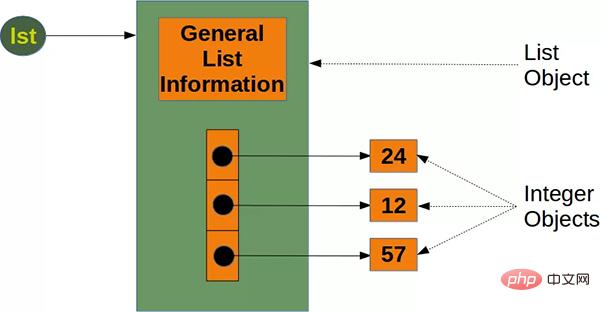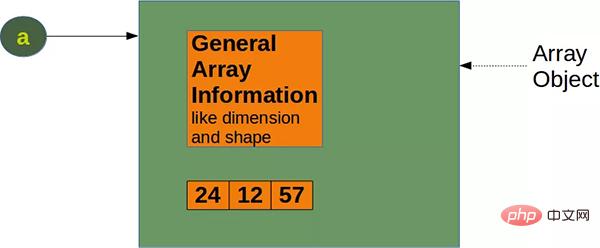Why must Python big data use Numpy Array?

Numpy is a core module of Python scientific computing. It provides very efficient array objects, as well as tools for working with these array objects. A Numpy array consists of many values, all of the same type.
Python's core library provides List lists. Lists are one of the most common Python data types, and they can be resized and contain elements of different types, which is very convenient.
So what is the difference between List and Numpy Array? Why do we need to use Numpy Array when processing big data? The answer is performance.
Numpy data structures perform better in the following aspects:
1. Memory size—Numpy data structures take up less memory.
2. Performance - The bottom layer of Numpy is implemented in C language, which is faster than lists.
3. Operation methods - built-in optimized algebraic operations and other methods.
The following explains the advantages of Numpy arrays over Lists in big data processing.
1. Smaller memory usage
If you use Numpy arrays instead of Lists appropriately, you can reduce your memory usage by 20 times.
For Python's native List, since every time a new object is added, 8 bytes are needed to reference the new object, and the new object itself occupies 28 bytes (taking integers as an example). So the size of the list can be calculated with the following formula:
64 8 * len(lst) len(lst) * 28 bytes

while using Numpy , which can reduce a lot of space occupied. For example, a Numpy integer Array of length n requires:
96 len(a) * 8 bytes

It can be seen that the larger the array, the more money you save The more memory space there is. Assuming your array has 1 billion elements, then the difference in memory usage will be on the GB level.
2. Faster, built-in calculation method
Run the following script, which also generates two arrays of a certain dimension and adds them together. You can see the native List and Numpy Array. performance gap.
import time
import numpy as np
size_of_vec = 1000
def pure_python_version():
t1 = time.time()
X = range(size_of_vec)
Y = range(size_of_vec)
Z = [X[i] + Y[i] for i in range(len(X)) ]
return time.time() - t1
def numpy_version():
t1 = time.time()
X = np.arange(size_of_vec)
Y = np.arange(size_of_vec)
Z = X + Y
return time.time() - t1
t1 = pure_python_version()
t2 = numpy_version()
print(t1, t2)
print("Numpy is in this example " + str(t1/t2) + " faster!")
The results are as follows:
0.00048732757568359375 0.0002491474151611328 Numpy is in this example 1.955980861244019 faster!
As you can see, Numpy is 1.95 times faster than native arrays.
If you are careful, you can also find that Numpy array can directly perform addition operations. Native arrays cannot do this. This is the advantage of Numpy's operation method.
We will do several more repeated experiments to prove that this performance advantage is durable.
import numpy as np
from timeit import Timer
size_of_vec = 1000
X_list = range(size_of_vec)
Y_list = range(size_of_vec)
X = np.arange(size_of_vec)
Y = np.arange(size_of_vec)
def pure_python_version():
Z = [X_list[i] + Y_list[i] for i in range(len(X_list)) ]
def numpy_version():
Z = X + Y
timer_obj1 = Timer("pure_python_version()",
"from __main__ import pure_python_version")
timer_obj2 = Timer("numpy_version()",
"from __main__ import numpy_version")
print(timer_obj1.timeit(10))
print(timer_obj2.timeit(10)) # Runs Faster!
print(timer_obj1.repeat(repeat=3, number=10))
print(timer_obj2.repeat(repeat=3, number=10)) # repeat to prove it!
The results are as follows:
0.0029753120616078377 0.00014940369874238968 [0.002683573868125677, 0.002754641231149435, 0.002803879790008068] [6.536301225423813e-05, 2.9387418180704117e-05, 2.9171351343393326e-05]
It can be seen that the second output time is always much smaller, which proves that this performance advantage is persistent.
So, if you are doing some big data research, such as financial data and stock data, using Numpy can save you a lot of memory space and have more powerful performance.
References:https://www.php.cn/link/5cce25ff8c3ce169488fe6c6f1ad3c97
Our article ends here, if you like Please continue to follow us for today’s Python practical tutorial.
The above is the detailed content of Why must Python big data use Numpy Array?. For more information, please follow other related articles on the PHP Chinese website!

Hot AI Tools

Undresser.AI Undress
AI-powered app for creating realistic nude photos

AI Clothes Remover
Online AI tool for removing clothes from photos.

Undress AI Tool
Undress images for free

Clothoff.io
AI clothes remover

Video Face Swap
Swap faces in any video effortlessly with our completely free AI face swap tool!

Hot Article

Hot Tools

Notepad++7.3.1
Easy-to-use and free code editor

SublimeText3 Chinese version
Chinese version, very easy to use

Zend Studio 13.0.1
Powerful PHP integrated development environment

Dreamweaver CS6
Visual web development tools

SublimeText3 Mac version
God-level code editing software (SublimeText3)

Hot Topics
 1670
1670
 14
14
 1428
1428
 52
52
 1329
1329
 25
25
 1274
1274
 29
29
 1256
1256
 24
24
 PHP and Python: Different Paradigms Explained
Apr 18, 2025 am 12:26 AM
PHP and Python: Different Paradigms Explained
Apr 18, 2025 am 12:26 AM
PHP is mainly procedural programming, but also supports object-oriented programming (OOP); Python supports a variety of paradigms, including OOP, functional and procedural programming. PHP is suitable for web development, and Python is suitable for a variety of applications such as data analysis and machine learning.
 Choosing Between PHP and Python: A Guide
Apr 18, 2025 am 12:24 AM
Choosing Between PHP and Python: A Guide
Apr 18, 2025 am 12:24 AM
PHP is suitable for web development and rapid prototyping, and Python is suitable for data science and machine learning. 1.PHP is used for dynamic web development, with simple syntax and suitable for rapid development. 2. Python has concise syntax, is suitable for multiple fields, and has a strong library ecosystem.
 How to run sublime code python
Apr 16, 2025 am 08:48 AM
How to run sublime code python
Apr 16, 2025 am 08:48 AM
To run Python code in Sublime Text, you need to install the Python plug-in first, then create a .py file and write the code, and finally press Ctrl B to run the code, and the output will be displayed in the console.
 PHP and Python: A Deep Dive into Their History
Apr 18, 2025 am 12:25 AM
PHP and Python: A Deep Dive into Their History
Apr 18, 2025 am 12:25 AM
PHP originated in 1994 and was developed by RasmusLerdorf. It was originally used to track website visitors and gradually evolved into a server-side scripting language and was widely used in web development. Python was developed by Guidovan Rossum in the late 1980s and was first released in 1991. It emphasizes code readability and simplicity, and is suitable for scientific computing, data analysis and other fields.
 Python vs. JavaScript: The Learning Curve and Ease of Use
Apr 16, 2025 am 12:12 AM
Python vs. JavaScript: The Learning Curve and Ease of Use
Apr 16, 2025 am 12:12 AM
Python is more suitable for beginners, with a smooth learning curve and concise syntax; JavaScript is suitable for front-end development, with a steep learning curve and flexible syntax. 1. Python syntax is intuitive and suitable for data science and back-end development. 2. JavaScript is flexible and widely used in front-end and server-side programming.
 Golang vs. Python: Performance and Scalability
Apr 19, 2025 am 12:18 AM
Golang vs. Python: Performance and Scalability
Apr 19, 2025 am 12:18 AM
Golang is better than Python in terms of performance and scalability. 1) Golang's compilation-type characteristics and efficient concurrency model make it perform well in high concurrency scenarios. 2) Python, as an interpreted language, executes slowly, but can optimize performance through tools such as Cython.
 Where to write code in vscode
Apr 15, 2025 pm 09:54 PM
Where to write code in vscode
Apr 15, 2025 pm 09:54 PM
Writing code in Visual Studio Code (VSCode) is simple and easy to use. Just install VSCode, create a project, select a language, create a file, write code, save and run it. The advantages of VSCode include cross-platform, free and open source, powerful features, rich extensions, and lightweight and fast.
 How to run python with notepad
Apr 16, 2025 pm 07:33 PM
How to run python with notepad
Apr 16, 2025 pm 07:33 PM
Running Python code in Notepad requires the Python executable and NppExec plug-in to be installed. After installing Python and adding PATH to it, configure the command "python" and the parameter "{CURRENT_DIRECTORY}{FILE_NAME}" in the NppExec plug-in to run Python code in Notepad through the shortcut key "F6".




